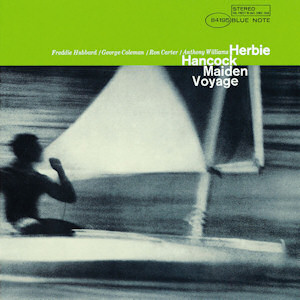
Maiden Voyage is the fifth album led by jazz musician Herbie Hancock, and was recorded by Rudy Van Gelder on March 17, 1965, for Blue Note Records. It was issued as BLP 4195 and BST 84195. Featuring Hancock with tenor saxophonist George Coleman, trumpeter Freddie Hubbard, bassist Ron Carter and drummer Tony Williams, it is a concept album aimed at creating an oceanic atmosphere. As such, many of the track titles refer to marine biology or the sea, and the musicians develop the concept through their use of space. The album was presented with the Grammy Hall of Fame Award in 1999.
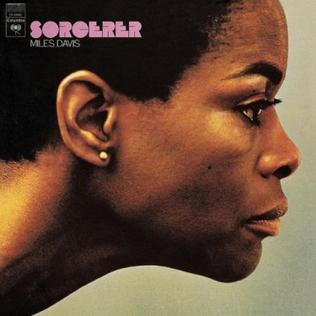
Sorcerer is an album recorded in May 1967 by the Miles Davis quintet. It is the third of six albums that this quintet recorded. It also includes one track from a 1962 session with vocalist Bob Dorough, which was the first time Wayne Shorter recorded with Davis. Davis does not play on the second track, "Pee Wee". The album's cover is a profile photo of actress Cicely Tyson, who at the time was Davis's girlfriend.
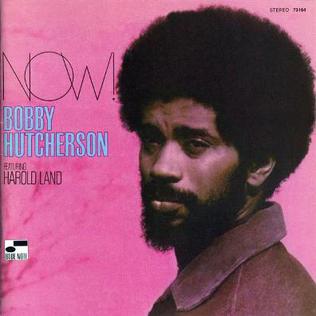
Now! is an album by jazz vibraphonist Bobby Hutcherson, released on the Blue Note label. The album is the first of Hutcherson's to feature vocals, contributed by Gene McDaniels and a chorus. The CD reissue includes four tracks recorded live at the Hollywood Bowl, in 1977.

Sextant is the eleventh studio album by Herbie Hancock, released in 1973 by Columbia. It is the last album with the Mwandishi-era sextet featuring saxophonist Bennie Maupin, trumpeter Eddie Henderson, trombonist Julian Priester, bassist Buster Williams and drummer Billy Hart. Synthesizer player Patrick Gleeson and percussionist Buck Clarke also appear.

Empyrean Isles is the fourth studio album by American jazz pianist Herbie Hancock, recorded on June 17, 1964 and released on Blue Note in November later that year. The quartet features trumpeter Freddie Hubbard and rhythm section Ron Carter and Tony Williams.

Adam's Apple is the tenth album by post-bop jazz artist Wayne Shorter. Recorded in 1966 and released in 1967, it included the first recording of his composition "Footprints", later recorded by the Miles Davis Quintet for the album Miles Smiles (1967). Shorter is featured with pianist Herbie Hancock, bassist Reggie Workman and drummer Joe Chambers. The CD release includes the Hancock composition "The Collector" as a bonus track.

William Correa, better known by his stage name Willie Bobo, was an American Latin jazz percussionist of Puerto Rican descent. Bobo rejected the stereotypical expectations of Latino music and was noted for combining elements of jazz, Latin and rhythm and blues music.

"Afro Blue" is a jazz standard composed by Mongo Santamaría.

My Point of View is the second album by pianist Herbie Hancock. It was released in 1963 on Blue Note Records as BLP 4126 and BST 84126. Musicians featured are trumpeter Donald Byrd, trombonist Grachan Moncur III, tenor saxophonist Hank Mobley, guitarist Grant Green, bassist Chuck Israels and drummer Tony Williams.

Takin' Off is the debut album by jazz pianist Herbie Hancock released in 1962 by Blue Note Records. Featuring veteran tenor saxophonist Dexter Gordon, trumpeter Freddie Hubbard, bassist Butch Warren and drummer Billy Higgins. The album is a creative example of music in the hard bop idiom. The bluesy track "Watermelon Man" made it to the Top 100 of the singles charts, and went on to become a jazz standard. Hancock released a funk arrangement of “Watermelon Man” on his 1973 album Head Hunters. Takin' Off was initially released on CD in 1996 and then again in remastered form in 2007 by Rudy Van Gelder.
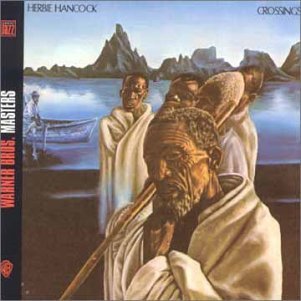
Crossings is the tenth album by jazz pianist Herbie Hancock, released in 1972. It is the second album in his Mwandishi period, which saw him experimenting in electronics and funk with a sextet featuring saxophonist Bennie Maupin, trumpeter Eddie Henderson, trombonist Julian Priester, bassist Buster Williams and drummer Billy Hart. The album is the band's first to feature synthesizer player Patrick Gleeson. He was scheduled to "set up his Moog for Hancock to play." However, Hancock was so impressed with Gleeson that he "asked Gleeson not only to do the overdubs on the album but join the group."

Miles Davis & Gil Evans: The Complete Columbia Studio Recordings is a box set of music by jazz musicians Miles Davis and Gil Evans originally released on CD in 1996 and remastered and re-released in 2004. It collects work from 1957 through 1968 at Columbia Records recording studios.

The Prisoner is the seventh Herbie Hancock album, recorded in 1969 and released in January 1970 for the Blue Note label, his final project for the label before moving to Warner Bros. Records. It is dedicated to the memory of Dr. Martin Luther King Jr., who had been assassinated the previous year. Hancock suggested at the time that he had been able to get closer to his real self with this music than on any other previous album. Participating musicians include tenor saxophonist Joe Henderson, trumpeter Johnny Coles, trombonist Garnett Brown, flautist Hubert Laws, bassist Buster Williams and drummer Albert “Tootie” Heath. Hancock praised flute player Laws, suggesting that he was one of the finest flautists in classical or jazz music.

Fat Albert Rotunda is the eighth album by jazz keyboardist Herbie Hancock, released in 1969. It was Hancock's first release for Warner Bros. Records after his departure from Blue Note Records. The music was originally done for the TV special Hey, Hey, Hey, It's Fat Albert, which later inspired the Fat Albert and the Cosby Kids TV show.

Etcetera is the eighth album by saxophonist Wayne Shorter, recorded on June 14, 1965, but not released on Blue Note until 1980. The album features four originals by Shorter and an arrangement of Gil Evans' "Barracudas" performed by a quartet with pianist Herbie Hancock, bassist Cecil McBee and drummer Joe Chambers.
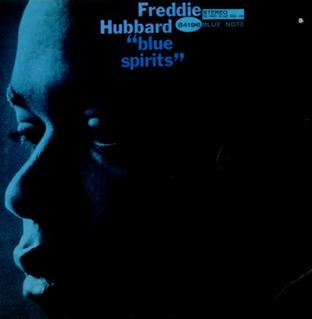
Blue Spirits is an album by trumpeter Freddie Hubbard released on the Blue Note label. It would be his last studio album for Blue Note, recorded in the 1960s. It features performances by Hubbard, James Spaulding, Joe Henderson, Harold Mabern, Jr., Larry Ridley, Clifford Jarvis, Big Black, Kiane Zawadi, Hank Mobley, McCoy Tyner, Bob Cranshaw, Pete LaRoca. The CD release added tracks from a 1966 session featuring Hosea Taylor, Herbie Hancock, Reggie Workman, and Elvin Jones.

Zawinul is the third studio album by jazz composer and pianist Joe Zawinul recorded in 1970 by Zawinul performing music arranged for two electric pianos, flute, trumpet, soprano saxophone, two contrabasses, and percussion. The album reached number 17 in the Billboard Jazz album charts.

Contours is the second album by American saxophonist Sam Rivers recorded in 1965 and released on the Blue Note label. The CD reissue contains an alternate take as a bonus track.

Quiet Nights is a studio album by American jazz trumpeter Miles Davis, and his fourth album collaboration with arranger and conductor Gil Evans, released in 1963 on Columbia Records, catalogue CL 2106 and CS 8906 in stereo. Recorded mostly at Columbia's 30th Street Studios in Manhattan, it is the final album by Davis and Evans.

Directions is a compilation album by American jazz musician Miles Davis, released in 1981 by Columbia Records. It collects previously unreleased outtakes that Davis recorded between 1960 and 1970. Directions was the last of a series of compilation albums—mostly consisting of, at that time, previously unreleased music—that Columbia released to bridge Davis' recording hiatus that ended with the Man with the Horn in July 1981.





















